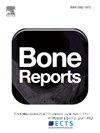Clinical features and treatment of hypophosphatemia and associated complications induced by Phosphaturic mesenchymal tumors: A case series of six patients
IF 2.6
Q3 ENDOCRINOLOGY & METABOLISM
引用次数: 0
Abstract
Phosphaturic mesenchymal tumor (PMT) is a rare benign mesenchymal tumor characterized by excessive secretion of fibroblast growth factor 23 (FGF23), leading to phosphate loss and systemic osteomalacia. Despite recent progress in PMT research, no consensus on diagnosis and treatment guidelines has been established. This case series describes the clinical and pathological features of six pathologically confirmed PMT patients treated at the Third Affiliated Hospital of Sun Yat-sen University from 2010 to 2024, aiming to provide new insights for the management of this condition. The patients, consisting of three males and three females with an average age of 44 years and follow-up periods of 0.5 to 4.5 years, presented primarily with muscle pain and lower limb weakness. One patient experienced loose teeth, and two had palpable, painless masses. One case developed hyperphosphatemia, tertiary hyperparathyroidism, and renal impairment after prolonged phosphate supplementation. Tumor localization was achieved using 18F-FDG or 68Ga-DOTATATE Positron Emission Tomography-Computed Tomography(PET/CT) and MRI, followed by complete surgical resection. Pathological examination confirmed PMT, and postoperative recovery was marked by significant symptom relief and normalization of serum phosphate levels. Two patients experienced recurrence within three years but showed no further recurrence following repeat surgery by the last follow-up. The diagnosis of PMT is challenging and may take years, potentially leading to complications due to inadequate treatment. Complete tumor resection remains the primary treatment, generally resulting in a favorable prognosis; however, long-term monitoring is essential to detect potential recurrences and initiate timely interventions.
6例含磷间充质肿瘤所致低磷血症及相关并发症的临床特点及治疗
磷酸盐间质瘤(PMT)是一种罕见的良性间质瘤,其特点是成纤维细胞生长因子23(FGF23)分泌过多,导致磷酸盐流失和全身性骨软化症。尽管近年来 PMT 的研究取得了进展,但在诊断和治疗指南方面尚未达成共识。本病例系列描述了中山大学附属第三医院自2010年至2024年收治的6例经病理证实的PMT患者的临床和病理特征,旨在为该病的治疗提供新的见解。这些患者包括三男三女,平均年龄为44岁,随访时间为0.5至4.5年,主要表现为肌肉疼痛和下肢无力。一名患者牙齿松动,两名患者可触及无痛性肿块。其中一例患者在长期补充磷酸盐后出现了高磷血症、三级甲状旁腺功能亢进症和肾功能损害。通过18F-FDG或68Ga-DOTATATE正电子发射计算机断层扫描(PET/CT)和磁共振成像确定了肿瘤的位置,随后进行了彻底的手术切除。病理检查证实为 PMT,术后症状明显缓解,血清磷酸盐水平恢复正常。两名患者在三年内复发,但在最后一次随访时,再次手术后未再复发。PMT 的诊断具有挑战性,可能需要数年时间,并可能因治疗不当而导致并发症。完全切除肿瘤仍是主要的治疗方法,一般来说预后较好;但是,长期监测对发现潜在复发和及时启动干预措施至关重要。
本文章由计算机程序翻译,如有差异,请以英文原文为准。
求助全文
约1分钟内获得全文
求助全文
来源期刊

Bone Reports
Medicine-Orthopedics and Sports Medicine
CiteScore
4.30
自引率
4.00%
发文量
444
审稿时长
57 days
期刊介绍:
Bone Reports is an interdisciplinary forum for the rapid publication of Original Research Articles and Case Reports across basic, translational and clinical aspects of bone and mineral metabolism. The journal publishes papers that are scientifically sound, with the peer review process focused principally on verifying sound methodologies, and correct data analysis and interpretation. We welcome studies either replicating or failing to replicate a previous study, and null findings. We fulfil a critical and current need to enhance research by publishing reproducibility studies and null findings.
 求助内容:
求助内容: 应助结果提醒方式:
应助结果提醒方式:


